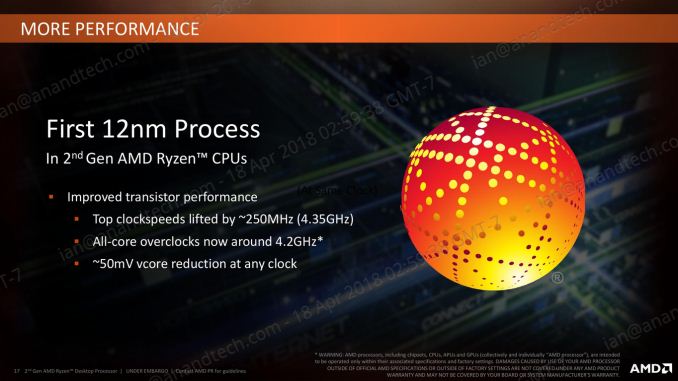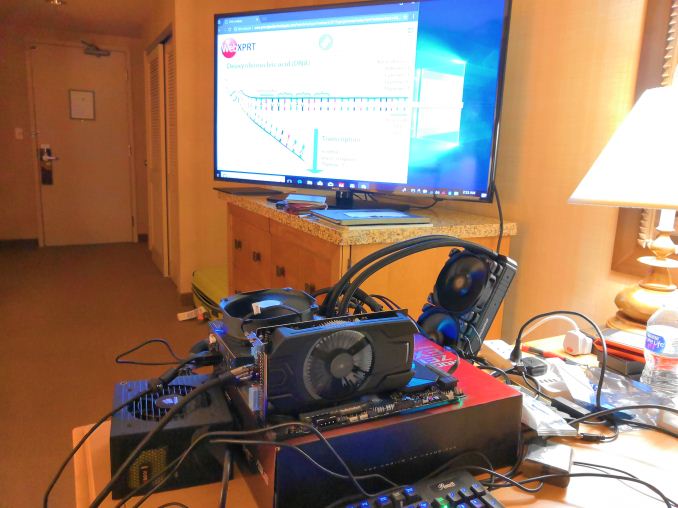The AMD Threadripper 2 Teaser: Pre-Orders Start Today, Up to 32 Cores
by Ian Cutress on August 6, 2018 9:00 AM ESTWhat Is New: Zen+ Updates
For all the new Ryzen Threadripper 2000 series, the Zen cores inside are in ‘Zen+’ mode, which affords three or four main new features, identical to the Ryzen 2000-series.
First up are the faster caches – as we saw in our Ryzen 7 2700X review, the L1 and L2 caches are slightly faster, the L3 cache gets a boost too, and the main memory support goes up from DDR4-2666 to DDR4-2933. All this accounts for a 3% IPC increase, and is the result of better understanding the design and tweaking the internal dials to extract best performance.
Second, the Zen+ cores also take advantage of GlobalFoundries' 12nm process, an enhanced version of their 14nm process used for Threadripper-1000. While not an optical shrink, it does allow AMD to extract higher frequencies as well as reduce voltage at the same time. Along with the new turbo methodology, combining this with the 3% IPC gain from the caches resulted in an overall 10% performance gain in the Ryzen 2000-series processors.
Third is Precision Boost 2, which manages how the CPU implements its turbo depending on workload. Rather than referring to a fixed turbo table, relating how many cores are active to a given frequency, PB2 now means that the internal sensors guide how much power/temperature is still available and prompts the CPU to increase frequency until it hits that barrier. Due to the 25 MHz granularity of the multiplier, this allows the processor to boost as much as possible for performance. We saw this on the Ryzen 2000-series processors and it worked really well, although it is worth noting that it does increase power consumption for variable threaded workloads.
Fourth is XFR2, or ‘eXtended Frequency Range’. This is essentially the ‘temperature’ bit of Precision Boost 2, but uses the benefits of a cooler ambient temperature and better cooling to push the processor frequency. In for the mainstream Ryzen 2000-series processors, this afforded up to a 10-15% performance increase. For today’s announcement, as this is not the embargo for performance numbers, we can’t give you hard data. However AMD included both the Wraith Ripper (a 250W-rated air cooler) and the Enermax Liqtech 240 (a 500W-rated liquid cooler) in our press kits for exactly this reason.
(A note here: we’re currently going through a heat wave in Europe, one of the biggest ever, and home air conditioning does not really exist in the UK. As a result, AMD has hit a spot of potential bad luck, as it means a lot of reviewers will be hampered by the super-high ambient (32C+) ‘home office’ temperatures. I have lucked out – Intel invited me to an event in San Francisco this week, so despite having to cart 30kg of kit 5500 miles away, I am currently testing in a thermally controlled 20C hotel room while on the road. All this being said, it would be interesting if European reviewers that are struggling in the heat this week were to re-test in a few months, when ambient temperatures are back to being reasonably cool. As for Americans, we all know you lot love your AC, especially in AMD's home state of Texas)
Sweet Memories
One of the big questions when AMD initially announced the second generation of Threadripper was around the memory configuration. In the first generation, the two active dies on the chip each used two memory channels giving a total of four. For the second generation, with four active dies, we now have a non-uniform memory design: two dies have access to two memory channels each, while the other two dies have zero memory channels directly connected, meaning that memory accesses require a hop.
To clarify, as people were speculating, the design is not one memory channel per die. While not impossible, doing it that way would require adjustment of the pin-out arrangement and Threadripper firmware. This is only designed to be a mid-generation microarchitecture refresh, not a full update. One of the benefits is that these processors should go straight in to all motherboards currently on the market without a BIOS flash, although once installed, an updated BIOS is recommended for enhanced memory and feature support.
When discussing the matter with AMD, they noted that this memory configuration means that the scheduler in the operating system will aim to fill in the cores directly attached to a memory controller first. However, it will not be a simple case of filling up 16 cores across the two directly connected dies first: after the first few threads are allocated, new threads will enter a round-robin mode, where the ‘value’ of a thread landing on a core changes based on how the other cores are loaded. If it makes sense for power and temperature reasons, threads will spawn on the silicon not directly attached to memory, for example. So it is something to note, as Threadripper 2 core scheduling isn't going to be as simple as it may initially appear.
While users were speculating on a fairer memory distribution, almost no-one touched upon the PCIe situation. As with the memory, the PCIe lanes will also only come from two of the silicon dies, rather than split between all four. Most if not all motherboards should support multiple graphics cards and other add-in devices as a result.















101 Comments
View All Comments
Tom_Joad - Wednesday, August 15, 2018 - link
Please, let AMD do well! I'll buy something from them, (my first PC was AMD) just to keep some competition alive. Death to Intel monopolistic practices, and the governments that let them get away with it!